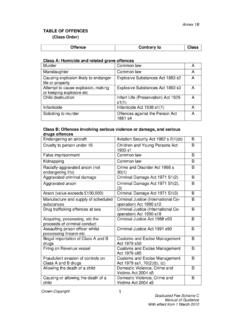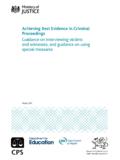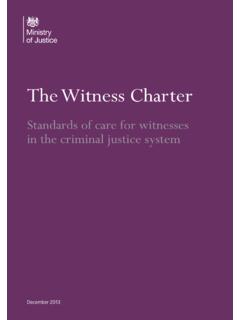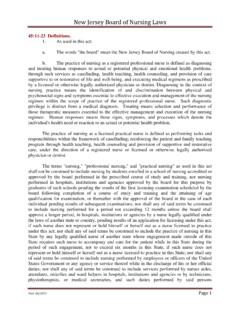Transcription of Guidelines on Prosecuting Cases Involving Communications ...
1 Protective Marking Official 1 Guidelines on Prosecuting Cases Involving Communications Sent via Social Media Contents Int roduct ion .. 1 Part A: Offence s - Substantive .. 2 Part A: Offence s Communications Offences .. 3 Selection of Charges .. 3 Sect ion 127 Time Limit .. 4 Articl e 10 .. 5 Evidential Stage of the Code for Crown Prosecu tors .. 6 Public Interest Stage of the Code for Crown Prosecutors .. 7 Evidence of Vict ims .. 8 Part B: Issues in Soci al Media Offending .. 9 Violence Against Women and Girls (VAWG) .. 9 Cyber-enabled VAWG Offence s.
2 10 Social Media VAWG Offence s .. 11 Non-social Media VAWG 11 Flagging .. 11 Hate Crime .. 11 Social Media Hate Crime 12 Sentencing Uplift .. 13 Flagging .. 13 Ancillary Orders .. 13 Vict im Personal Statements .. 14 Community Impact Statements .. 14 Reporting and Preventing Abuse on Soci al Media .. 14 Ju risdiction .. 15 Handling Arrangements .. 15 Intr oduction 1. Social media commonly refers to the use of electronic devices to cr eate, sh are or exchange information, ideas, pict ures and videos with others via virtual communities and networks.
3 2. Communications sent via so cial media may involve the co mmission of a range of existing offence s against the person, public justice, se xual or public order offences. They may also involve the commission of Communications offences ( the Protective Marking Official 2 co mmunications offences ) contrary to se cti on 1 Malicious Communica tions Act 1988 ( secti on 1 ) and / or secti on 127 Communications Act 2003 ( secti on 127 ). These alternative possibilities are dealt with in Part A. Broader issues in so ci al media offending of whatever form are dealt with in Part B.
4 3. The follo wing propose d decisions (or decisions, where CPSD with DCCP / CCP approval, has taken them given the urgency) must be referred to the Director s Legal Advisor for approval: a. Any proposal to charge a co mmunications offence where the allegation is one of gross offence, obscenity or indecency: i. Secti on 1(1)(a)(i) and 1(1)(b); ii. Secti on 127(1) save for the reference to menacing . b. Any proposal to charge or NFA any co mmunications offence (se ction 1 or 127) where directed towards a perso n of public prominence. 4.
5 Accordingly, decisions to NFA Communications offences other than those relating to persons of public prominence do not require referral to the DLA. Decisions to charge offences other than those relating to persons of public prominence, co ntrary to se ction 1(1)(a)(ii) and (iii) and se ction 127(1) (menacing only) and (2), do not require referral to the DLA. 5. For approval of decisions, please contact the Director s Legal Advisor s Team @cp For policy enquiries, contact HQPolicy@cp Part A: Offences - Substanti ve 6. Where social media is use d to facilitate a substantive offence, prose cu tors should proce ed under the substantive offence in questi on, having regard as appropriate to the Hate Crime and VAWG secti ons below.
6 7. The follo wing are potential offences against the person, against public justice or se xual offence s, with links to the relevant guidance, which prose cutors may consider: Making a threat to kill, contrary to secti on 16 Offence s Against the Perso n Act 1861 Making a threat to co mmit cr iminal damage, contrary to se ction 2 Criminal Damage Act 1971 Harassment or stalking, contrary to se ctions 2, 2A, 4 or 4A Protection from Harassment Act 1997 Controlling or coercive behaviour, co ntrary to se cti on 76 Serious Crime Act 2015 Blackmail, co ntrary to se cti on 21 Theft Act 1968 Juror misconduct, contrary to se cti ons 20A-G Ju ries Act 1974* Contempt of court.
7 Co ntrary to the Contempt of Court Act 1981* Publishing material which may lead to the identification of a complainant of a se xual offence , contrary to secti on 5 Sexual Offences (Amendment) Act 1992* Intimidating a witness or juror, co ntrary to se cti on 51 Criminal Justice and Public Order Act 1994 Breach of automatic or discretionary reporting restrictions, co ntrary to se cti on 49 Child ren and Young Persons Act 1933 and secti on 45 Youth Justi ce and Criminal Evidence Act 1999 Protective Marking Official 3 Breach of a restraining order.
8 Co ntrary to secti on 5 Protecti on from Harassment Act 1997 *Note that these offences require attorney General s consent to prosecu te and should be referred to the DLA Team prior to any su ch su bmission Disclosing private se xual images without co nsent ( revenge pornography ), contrary to se ction 33 Criminal Justice and Courts Act 2015 Causing se xual acti vity without co nsent, or causing or inciting a child to engage in se xual acti vity, or sexual communication with a ch ild contrary to se ctions 4, 8, 13, 15A Sexual Offences Act 2003 Taki ng, dist ribution, possessing or publishing indecent photographs of a ch ild, contrary to se ction 1 Protecti on of Child ren Act 1978 Alle gations contrary to Part III Public Order Act 1986 should be referred to Special Crime and Counter Terrorism Division.
9 8. The act of setting up a false so cial networking account or website, or the cr eation of a false or offensive profile or alia s could amount to a cr iminal offence, depending on the circu mstance s. For example: The former estranged partner of a victim cr eates a profile of the victim on a Facebook page, to attack the charact er of the victim, and the profile includes material that is grossly offensive, false, menacing or obscene. A "photoshopped" (digitally edited) image of a perso n is created and posted on a so cial media platform.
10 Although many photoshopped images are humorous and inoffensive, others are dist urbing or sinist er, such as the merging of a perso n's face with the nude body of another to cr eate obsc ene images, which may be accompanied by offensive co mment. 9. Depending on the ci rcu mstance s, this may be a way in which one of the offences above are committed, or it may be a way in which a Communications offence (as these include false Communications or messa ges) is committ ed. Part A: Offences Communica tions Offences 10. Where so cial media is not being use d to co mmit another substantive offence, prose cu tors may turn to consider the Communications offences available.

















